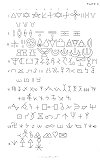
Sacred Texts Gnosticism Index Previous Next
Buy this Book at Amazon.com


The Gnostics and Their Remains, by Charles William King, [1887], at sacred-texts.com

Click to enlarge
Plate O
I. No. 1. Type of Mahadeva or Siva. Fire personified.
No. 2. Type of Vishnu: Water.
No. 3. The Sherkun: symbol of the union of the two Elements.
No. 4. The five-pointed figure representing the, conjunction of Brahma (Creator) with Siva (Destroyer) becomes the famous "Solomon's Seal," the badge of the Jewish nation, and therefore engraved upon their tombs in the Roman Catacombs.
The equilateral Triangle, Trikun, symbolises Triune Co-equality. A Point (mathematical) the self-existing Deity. The circle expresses Brahma, or Eternity. The Triangle inscribed in the Circle, Trinity in Unity. The Circle within the Triangle, Unity in Trinity.
The worshippers of a Sacti (Female Power) mark their sacred jars with the very expressive symbol, No. 5; those of Vishnu with No. 6; and those of Siva with No. 8, which signifies the copulation of Siva with Durga.
Amongst the signatures of the ancient Jaina (Buddhist) kings, occur the symbols 8 and 9; and also the so-called "Maeander," that frequent decoration of Greek Coins.
The six following symbols are various Caste-marks, which religious Hindoos put upon their foreheads every morning, with ashes of cowdung, or coloured earths, and powdered sandalwood, producing a great variety in them by the employment of different colours. Those figured here designate the followers of Vishnu.
II. These marks distinguish the votaries of Siva and his wife, Parvati. The most obvious symbol of the Passive Principle of Nature, the mystic Yoni, (and with which Sesostris branded the nations that had submitted to his arms without resistance) is decorously repressed in the general form of these marks, the two Deities being those that preside over propagation and change which the vulgar call by the name of Death.
III. Other caste-marks, denoting minor differences in the sects that bear them: they are given here because they include in their number some that appear to have been the originals of certain Mediæval siglæ.
IV. Characters cut upon the rock in the sandstone quarries of Silsilis
in Upper Egypt. That they are alphabetical may be inferred from the fact of their accompanying the figures of various animals; they are of great interest to us, being identical with those so often found upon our talisman.
V. Palmyrene characters from a finely-cut inscription now in the Louvre.
VI. Siglæ, exactly of the nature of Masons’ Marks, and of very ancient date, for they are found on the pottery deposited in the Gallic tombs around Bologna. Some are stamped in the clay before baking, and therefore must have indicated the maker's name; but the greater number have been scratched on the surface at some later time, probably when placed in the sepulchre, to carry down to posterity the memory of the deceased. Those here given are selected from the list figured by the Conte Gozzalini in his very instructive memoir 'Gli Scavi presso Bologna,' 1877.
VII. Masons’ Marks, cut on the ashlar of the old Palace of Sadilat, near Ispahan, whence they were copied by Ouseley, in the belief that they were inscriptions in some unknown tongue.
VIII. Masons’ Marks from the "Drawing-room" of Raglan Castle, an Elizabethan building. They will suffice for specimens of the notation, all the mediæval, early or late, being of the same nature, though infinitely varied in minor details. Many lists of these have been published from time to time, the most recent, of the Marks in Duffield Church, a Norman building, published in the Journal of the Derbyshire Arch. Soc., ix. p. 168.
IX. Every genuine Free Mason (not Rosicrucian recoctus Freemason) after serving his apprenticeship, and being made "free and accepted" of the Craft, receives his own "Mark," which he must thenceforth cut upon every stone that he dresses, in order to identify his own work when payday comes. The essential principle in the Mark is that it must have an odd number of terminations. The Marks here set down were in use with the masons employed in the construction of the South Wales Railway. The most convincing proof of the emptiness of the lofty pretensions of our so-called Freemasons, is that they actually are entirely ignorant that this most ancient rule of the Craft, to which they pretend to belong, is still regularly followed.